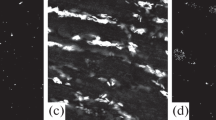Abstract
The acetylcholine-receptor protein (AchR) plays a key role in synaptic transmission because it controls the cation permeability of the postsynaptic membrane. It is an integral membrane glycoprotein of ≃ 3 x 105 daltons molecular weight, composed of several Polypeptide chains. Reports of its detailed chemical subunit composition and the number of ligandor neurotoxin binding sites are controversial [1, 2]. In purified postsynaptic membrane fragments (microsacs, see Fig. la) prepared from tissues rich in acetylcholine receptor, AchR is visualized by negative staining as densely packed round particles of ≃ 70 Å diameter [3,4,5,6], which are somewhat irregularly shaped (see also Fig. 1b). These particles possess a stain-filled central pit of ≃ 20 Å diameter. The terms “dough- nuts” or “rosettes” are often used to describe this appearance, which is due to a hydrated portion of AchR, protruding from the external surface of the microsac membrane by about 50 Å [6,7,8].
Access this chapter
Tax calculation will be finalised at checkout
Purchases are for personal use only
Preview
Unable to display preview. Download preview PDF.
Similar content being viewed by others
References
Heidmann T, Changeux J-P (1978) Structural and functional properties of the acetylcholine receptor protein in its purified and membrane-bound State. Annu Rev Biochem 47: 317–357
Barrantes FJ (1979) Endogenous chemical receptors: Some physical aspects. Annu Rev Biophys Biogen 8: 287–321
Nickel E, Potter LT (1973) Ultrastructure of isolated membranes of Torpedo electric tissue. Brain Res 57: 508–517
Cartaud J, Benedetti EL, Cohen JB, Meunier J-C, Changeux J-P (1973) Presence of a lattice structure in membrane fragments rich in nicotinic receptor protein from the electric organ of Torpedo marmorata. FEBS Lett 33: 109–113
Cartaud J, Benedetti EL, Sobel A, Changeux J-P (1978) A morphologieal study of the cholinergic receptor protein from Torpedo marmorata in its membrane environment and in its detergent- extracted purified form. J Cell Sci 29: 313–337
Schiebler W, Hucho F (1978) Membranes rich in acetylcholine receptor: Characterization and reconstitution to excitable membranes from exogenous lipids. Eur J Biochem 85: 55–63
Ross MJ, Klymkowsky MW, Agard DA, Stroud RM (1977) Structural studies of a membrane- bound acetylcholine receptor from Torpedo marmorata. J Mol Biol 116: 635–659
Klymkowsky MW, Stroud RM (1979) Immunospecific identification and three-dimensional structure of a membrane-bound acetylcholine receptor from Torpedo californica. J Mol Biol 128: 319–334
Brisson A (1978) Acetylcholine receptor protein structure. 10th Int Congr Electron Microsc, vol II, pp 180–181. Toronto
Sobel A, Changeux J-P (1977) Purification and characterization of the cholinergic receptor protein in its membrane-bound and detergent soluble forms from the electric organ of Torpedo marmorata. Biochem Soc Trans 5: 511–514
Unwin PNT (1974) Electron microscopy of the stacked disk aggregate of tobacco mosaic virus protein. II. The influence of electron irradiation on the stain distribution. J Mol Biol 87: 657–670
Crewe AV, Langmore JP, Isaacson MS (1975) Resolution and contrast in the scanning transmission electron microscope. In: Siegel B, Beaman DR (eds) Physical aspects of electron microscopy and microbeam analysis, pp 47–62. John Wiley & Sons, New York
Erickson HP, Klug A (1971) Measurement and compensation of defocussing and aberrations by fourier processing of electron micrographs. Philos Trans R Soc London Ser B 261: 105–118
Zingsheim HP, Bachmann L (1971) Elektronenmikroskopische Untersuchungen an Molekülen von Hochpolymeren. Kolloid Z Z Polym 246: 561–570
Ottensmeyer FP, Andrew JW, Bazett-Jones DP, Chan ASK, Hewitt JJ (1977) Signal to noise enhancement in dark field electron micrographs of Vasopressin: Filtering of arrays of images in reciprocal Space. J Microsc 109: 259–268
Lugt van der A (1964) Signal detection by complex spatial filtering. IEEE Trans lnf Theory IT-10: 139–145
Frank J, Goldfarb W, Eisenberg D, Baker TS (1978) Image Reconstruction of low and high dose micrographs of negatively stained glutamine synthetase. Proc 9th Int Congr Electron Microsc, vol II, pp 8–9. Toronto
Frank J, Goldfarb W, Eisenberg D, Baker TS (1978) Reconstruction of glutamine synthetase using Computer averaging. Ultramicroscopy 3: 283–290
Frank J, Shimkin B (1978) A new image processing Software system for structural analysis and contrast enhancement. Proc 9th Int Congr Electron Microsc, vol I, pp 210–211. Toronto
Crowther RA, Arnos L (1971) Harmonic analysis of electron microscope images with rotational symmetry. J Mol Biol 60: 123–130
Markham R, Frey S, Hills GJ (1963) Methods for enhancement of image detail and accentuation of structure in electron microscopy. Virology 20: 88–102
Frank J, Bussler PH, Langer R, Hoppe W (1970) Einige Erfahrungen mit der rechnerischen Analyse und Synthese von elektronenmikroskopischen Bildern hoher Auflösung. Ber Bunsenges Phys Chem 74: 1105–1115
Chang HW, Bock E (1977) Molecular forms of acetylcholine receptor. Effects of calcium ions and a sulfhydryl reagent on the occurence of oligomers. Biochemistry 16: 4513–4520
Author information
Authors and Affiliations
Editor information
Editors and Affiliations
Rights and permissions
Copyright information
© 1980 Springer-Verlag Berlin Heidelberg
About this paper
Cite this paper
Zingsheim, H.P., Neugebauer, DC., Barrantes, F.J., Frank, J. (1980). Image Averaging of Membrane-Bound Acetylcholine Receptor from Torpedo marmorata . In: Baumeister, W., Vogell, W. (eds) Electron Microscopy at Molecular Dimensions. Proceedings in Life Sciences. Springer, Berlin, Heidelberg. https://doi.org/10.1007/978-3-642-67688-8_19
Download citation
DOI: https://doi.org/10.1007/978-3-642-67688-8_19
Publisher Name: Springer, Berlin, Heidelberg
Print ISBN: 978-3-642-67690-1
Online ISBN: 978-3-642-67688-8
eBook Packages: Springer Book Archive




